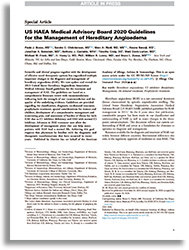The treatment of HAE has undergone dramatic changes as newer medicines have become available in recent years. Optimal care of people with HAE requires a comprehensive management plan. The US HAEA Medical Advisory Board has developed evidence-based recommendations for the diagnosis and treatment of HAE. If your doctor is unsure how to treat you or your loved one, please contact an HAE Advocate who can help you get in touch with an HAE expert physician in your area.

The US HAEA joined forces with the prestigious medical journal, Allergy and Asthma Proceedings, and HAE physician-experts to develop a special supplementary Primer on HAE diagnosis and management. The Primer contains 14 peer-reviewed articles on a range of vitally important HAE topics.
To view the Primer, please click here.

According to recent studies, pregnancy may aggravate or alleviate symptoms in equal proportion. It is important to create an individualized HAE treatment plan during pregnancy. Anabolic steroids, also known as androgens (such as danazol, oxandrolone, stanozolol, etc.), should be avoided during pregnancy. There are studies published on FDA-approved HAE therapies and pregnancy that should be read and considered when developing an HAE treatment plan during pregnancy. Importantly, people with HAE and their physicians should plan to have an acute treatment available upon delivery.
VISIT OUR PREGNANCY PAGEPublished in a peer-reviewed medical journal, original HAEA research — based on 800 people with HAE — reveals that the new subcutaneous preventive therapies yield (1) substantial economic value in light of remarkable decreases in attack frequency and (2) statistically significant improvements in patient quality of life. To view the study, please click here.

This Q&A, provided by Dr. Marc Riedl, Professor of Medicine and Clinical Director of the US HAEA Angioedema Center at UCSD and US HAEA Medical Advisory Board Member, offers a concise, patient-friendly overview of HAE treatment guidelines.